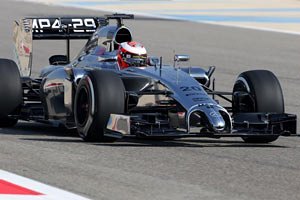turbof1 wrote:dren wrote:turbof1 wrote:
It creates in conjunction with the neutral section of the mainplane a venturi tunnel, dropping pressure and improving front downforce and air extraction, sucking in more air volume that'll move to the rear.
A venturi? Look straight on, the nose is directly in front of the part behind it. To me it looks more like flow management to the under nose flow conditioners. I'm guessing they had issues with the flow joining again behind the protrusion.
Yes it'll unfortunaly block the airflow a bit. Though the nose is shaped in a such a way it'll try to keep airflow attached and draw it directly behind it.
However, the solution is no different in concept from the pelican noses we saw last year at red bull and lotus. It creates a venturi tunnel just as last year, just a bit less effective due bodywork being in front of it.
The bulge also aids in airflow attachment as you said. Without the bulge a thick boundary layer would probably build up behind the nose. But again: one advantage will not exclude the other and will still create a venturi tunnel.
A few things.
1. This bulge underneath the nose will only work in yaw. That is because in front of the bulge is the nose extension. As a result, in a straight line, the airflow passes around the nose and straight backwards and the bulge has no effect. However in a corner (yaw) there will be a flow of air going at an angle to the bulge. This will create the Venturi like shape and decrease the pressure in that region as the airflow speeds up.
By my understanding, if it works correctly there will be a minimal drag increase in a straight line yet in a corner there will be a downforce increase. If this effect is true then it may create a problem of increasing mid corner grip for long sweeping corners but may not have the immediate "bite" for turn in as the airflow under the nose will still be going in a straight line.
2. It won't "draw" any more air under the nose. The bulge is a restriction. A restriction that large most likely can't speed up the airflow enough for there to be a higher mass of air (per second) than if the restriction was simply not in place.
3. One thing it does look like the bulge might do in corners is reduce any turbulent airflow coming off of the nose extension in yaw conditions.
4. Boundary layer control and flow attachment. Flow attachment and boundary layer control are, while associated in some situations, two separate issues. Problems with flow attachment lend themselves to a thick boundary layer.
I highly doubt that the bulge reduces the boundary layer thickness. If that is true then the turbulence caused by the nose extension must have been very bad.
The two main causes of a boundary layer increasing in thickness are surface friction and turbulence along a surface. A boundary layer is simply the slowing of airflow the closer you get to a surface. Therefore if you increase the surface area and make the airflow move around and object more then it stands to reason that the boundary layer will get thicker. It may be possible that if the turbulence from the nose extension was so bad that the increase in surface area, and hence surface drag, and extra shape to move around is offset by the reduction in turbulence but to my knowledge it is unlikely.
5. To me it looks as if McLaren are sacrificing some airflow to the back of the car. On a car with the rear end grip as good as the MP4-29 it may make sense that the drivers are looking for more front end grip that can be matched at the rear. The trade off will probably be increased drag and slight lack of turn in grip. Rear end grip was never a problem as evidenced by the fact that they were constantly running the car without the suspension mushrooms even in some tracks that required a high level of DF, add this to the fact that drivers were constantly asking for more front wing and then being told that there was no more.
6. Left this point for last. I believe that this nose has something to do with next years nose regulations. They did say that all the upgrades from, I think, summer forwards were going to be relevant to the 2015 car. Following on from that train of thought that it makes sense that this nose is designed to be checking things, whether they be structural or aero, that are relevant to next season.





















